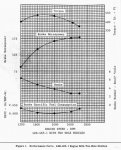From Tom Monroe:..." Failure of either on of these [rod bolts] usually means catastrophic engine failure. For rod bolts this typically occures when the rods are stressed in tension to the maximum, or just after the piston goes over TDC during the intake/exhaust overlap period. The crank pin pulls the rod-and-piston assembly down against the inertia of the whole assembly when pressure in the cylider is lowerst, creating maximum tension load on the rod...... You can prevent the above form happening by chosing rod bolts wisely, then being relentless as a Marine Corps DI during inspection. Rod manufactures provide information and support necessary to ensure inspection and installation are done correctly. They know from experience that if a rod failure occures, it will be rod bolt related due to an error made during inspection or installation. Other than minor bending stress that occures when the rod is in tension and compression as the big-end bore distorts to a slight oval shape, the onlu additional load a rod bolt should see is static tension from tightening during installation. this makes it critical that rod-bolts are preloaded as accurately as possible, or about 80% of yield strength. This eliminates cyclical stress, which also eliminates fatigue sress and ultimate bolt failure. so a bolt that is not tightened enough wll break before one that is over-tightened provided the bearing dowesnt spin first. this is caused by bearing crush relieved as the bolts stretch, alllowing the cap to seperate from the rod."
I think jimk hit it on the head!
Chuck, perhaps destructive testing isnt the best idea. I work in the aviation maint field and have access to many NDI (non destructive inspection) lab tests from magnetic to xray. I doubt i could make a metalurgical analysis, but could def gain more knowledge of the stock rod bolts and rods themselvsand i think its backwards...un torqued bolts fail first, over torqued fails over time. but an analysis of the bolts would show how they broke, either over stress or fatuige.
Mike, thanks for the data! I will find a formula to crank out the G-forces that are being had on the rod/pin/crank. from that we wll be able to see if thier is a great difference between lds and ldt pitons as far as weight and acceleration is concerned.
All, yeah its kind of hard to tell what broke first. to me its a chicken and the egg thing. but you can tell what broke from what kind of damage. you can find stresses, burns, impacts, and fatiuge. From there, deductive reasoning can be applied.
to add, i havent seen any pictures of the big end still attatched to the crank pin and the rod actually snapped at any place. the pictures i have seen look like they are all big end, rod cap or bolt failures.
also, i did touch on balance in my first post, it is a fairly important issue, but by the looks of things through discussion, the balance doesnt appear to be the problem.
Thanks everyone for all the good inputs, keep it coming.
and if anyone has a snapped rod and bolt they would like to have analyized, pm me and I will give you the address to my ship and you can send it out!


